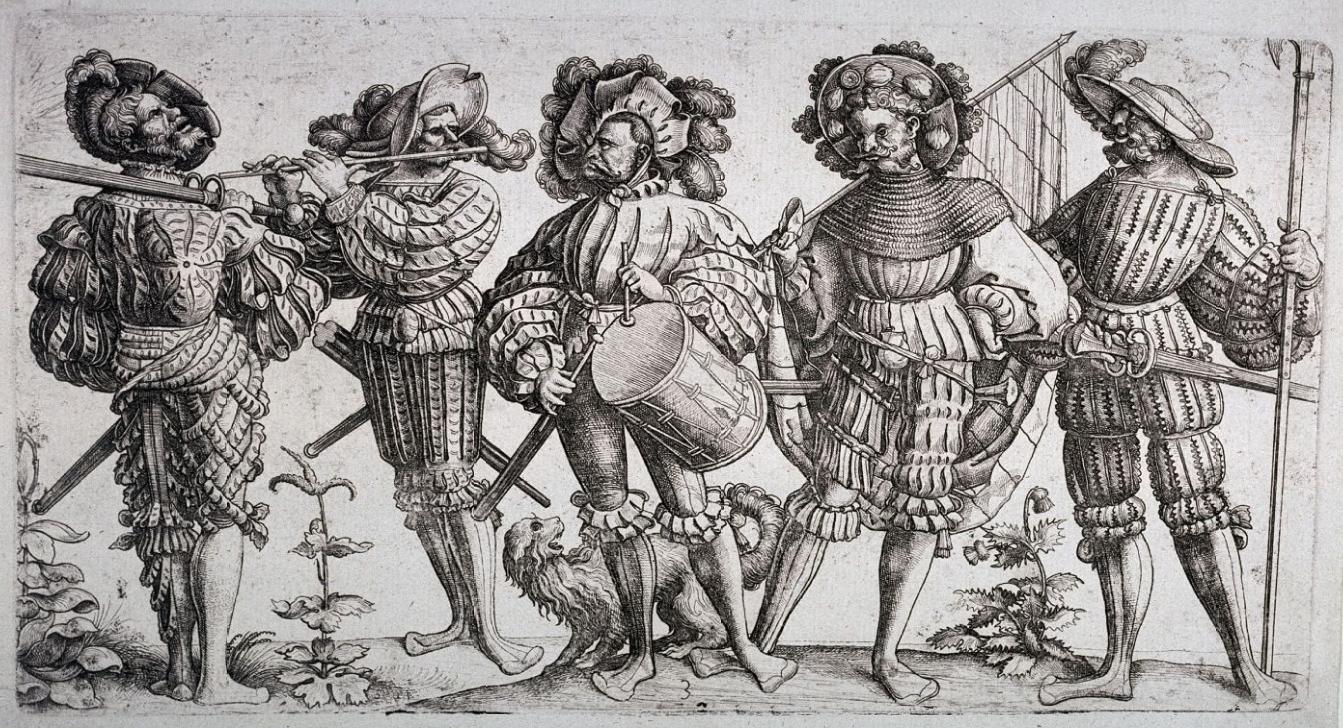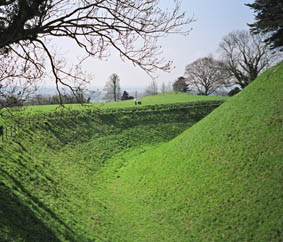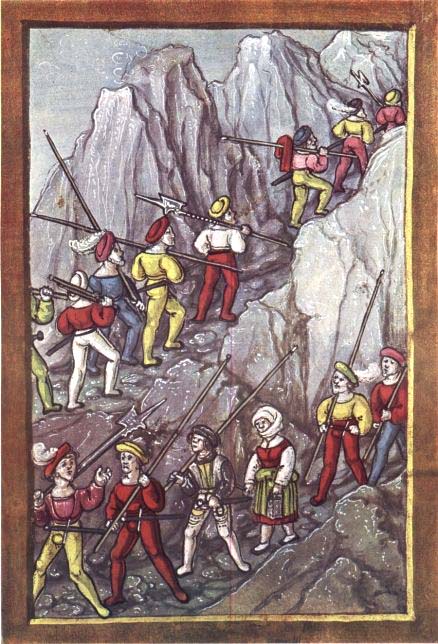|
Battle Of Cerignola
The Battle of Cerignola was fought on 28 April 1503 between Spanish and French armies outside the town of Cerignola, Apulia, Kingdom of Naples (now in modern-day Italy), approximately west of Bari. The Spanish force under the command of Gonzalo Fernández de Córdoba (''El Gran Capitán'') comprising 6,300 men, including 2,000 ''Landsknecht'' pikemen, 1,000 arquebusiers and 20 cannons, defeated the French force of 9,000 men, mainly gendarme heavy cavalry and Swiss mercenary pikemen, with about 40 cannons, led by Louis d'Armagnac, Duke of Nemours, who was killed during the battle. It was one of the first European battles won by gunpowder weapons, as the attacks by the French cavalry and Swiss pikemen were shattered by the fire of Spanish arquebusiers behind a defensive ditch. Preparations The Third Italian War was re-kindled in late 1502, over disagreements stemming from the secret Treaty of Granada, signed on 11 November 1500. Although it was agreed that Louis XII of Fran ... [...More Info...] [...Related Items...] OR: [Wikipedia] [Google] [Baidu] |
Italian Wars Of 1499–1504
The Italian Wars of 1499-1504 are divided into two connected, but distinct phases: the Second Italian War (1499–1501), sometimes known as Louis XII's Italian War, and the Third Italian War (1502-1504) or War over Naples. The first phase was fought for control of the Duchy of Milan by an alliance of Louis XII of France and the Republic of Venice against Ludovico Sforza, the second between Louis and Ferdinand II of Aragon for possession of the Kingdom of Naples. In the aftermath of the Italian War of 1494–1498, Louis was determined to pursue French claims to Milan and Naples and in October 1499 he captured Milan, which remained in French hands for the next thirteen years. His invasion of Naples in 1501 eventually led to war with Ferdinand of Aragon, who expelled the French in 1504. Timeline This is an overview of notable events including battles during the wars. ;Prelude (1498–1499) * 7 April 1498: Charles VIII of France died and was succeeded by his cousin Louis, ... [...More Info...] [...Related Items...] OR: [Wikipedia] [Google] [Baidu] |
Landsknecht
The (singular: , ), also rendered as Landsknechts or Lansquenets, were Germanic mercenaries used in pike and shot formations during the early modern period. Consisting predominantly of pikemen and supporting foot soldiers, their front line was formed by ''Doppelsöldner'' ("double-pay men") renowned for their use of ''Zweihänder'' and arquebus. Originally organized by Emperor Maximilian I and Georg von Frundsberg, they formed the bulk of the Holy Roman Empire's Imperial Army from the late 1400s to the early 1600s, fighting in the Habsburg-Valois wars, the Habsburg-Ottoman wars, and the European wars of religion. Although prone to mutiny if unpaid and divided within their ranks between Catholics and Lutherans, the ''Landsknechte'' were well-armed, experienced, and fierce warriors. In addition, they were recruitable in large numbers throughout Germany and Austria by the Holy Roman Emperor and thus guaranteed both quantity and quality to the Imperial military for a century a ... [...More Info...] [...Related Items...] OR: [Wikipedia] [Google] [Baidu] |
Louis XII
Louis XII (27 June 14621 January 1515), was King of France from 1498 to 1515 and King of Naples from 1501 to 1504. The son of Charles, Duke of Orléans, and Maria of Cleves, he succeeded his 2nd cousin once removed and brother in law at the time, Charles VIII, who died without direct heirs in 1498. Before his accession to the throne of France, he was known as Louis of Orléans and was compelled to be married to his disabled and supposedly sterile cousin Joan by his second cousin, King Louis XI. By doing so, Louis XI hoped to extinguish the Orléans cadet branch of the House of Valois. Louis of Orléans was one of the great feudal lords who opposed the French monarchy in the conflict known as the Mad War. At the royal victory in the Battle of Saint-Aubin-du-Cormier in 1488, Louis was captured, but Charles VIII pardoned him and released him. He subsequently took part in the Italian War of 1494–1498 as one of the French commanders. When Louis XII became king in 1498, he had ... [...More Info...] [...Related Items...] OR: [Wikipedia] [Google] [Baidu] |
Treaty Of Granada (1500)
The Treaty of Granada (1500), signed on 11 November 1500, was a secret treaty between Ferdinand II of Aragon and Louis XII of France, in which they agreed to partition the Kingdom of Naples. Background Following the death of Charles IV of Anjou in 1481, the Angevin claim to the Kingdom of Naples passed to Louis XI, then to his son Charles VIII of France in 1483. Although Charles conquered Naples with relative ease in the Italian War of 1494–1495, after his return to France, Ferdinand II of Naples quickly regained his kingdom. He did so with support from his distant relative Ferdinand II of Aragon, who as ruler of the neighbouring Kingdom of Sicily viewed French expansion in Southern Italy as a threat. In September 1496, Ferdinand of Naples was succeeded by his uncle Frederick. Charles died in April 1498 and his claims to Naples and the Duchy of Milan were taken up by his successor, Louis XII. Aware of the hostility caused by French ambitions in Italy, in July 1498 Louis renew ... [...More Info...] [...Related Items...] OR: [Wikipedia] [Google] [Baidu] |
Ditch (fortification)
In military engineering, a ditch is an obstacle designed to slow down or break up an attacking force, while a trench is intended to provide cover to the defenders. In military fortifications the side of a ditch farthest from the enemy and closest to the next line of defence is known as the scarp while the side of a ditch closest to the enemy is known as the counterscarp. Uses In early fortifications, ditches were often used in combination with ramparts to slow down the enemy whilst defensive fire could be brought to bear from the relative protection afforded by the rampart and possibly the palisade. In medieval fortification, a ditch was often constructed in front of a defensive wall to hinder mining and escalade activities from an attacker. When filled with water, such a defensive ditch is called a moat. However, moats may also be dry. Later star forts designed by military engineers like Vauban, comprised elaborate networks of ditches and parapets, carefully calculated ... [...More Info...] [...Related Items...] OR: [Wikipedia] [Google] [Baidu] |
Gunpowder
Gunpowder, also commonly known as black powder to distinguish it from modern smokeless powder, is the earliest known chemical explosive. It consists of a mixture of sulfur, carbon (in the form of charcoal) and potassium nitrate (saltpeter). The sulfur and carbon act as fuels while the saltpeter is an oxidizer. Gunpowder has been widely used as a propellant in firearms, artillery, rocketry, and pyrotechnics, including use as a blasting agent for explosives in quarrying, mining, building pipelines and road building. Gunpowder is classified as a low explosive because of its relatively slow decomposition rate and consequently low brisance. Low explosives deflagrate (i.e., burn at subsonic speeds), whereas high explosives detonate, producing a supersonic shockwave. Ignition of gunpowder packed behind a projectile generates enough pressure to force the shot from the muzzle at high speed, but usually not enough force to rupture the gun barrel. It thus makes a good propellan ... [...More Info...] [...Related Items...] OR: [Wikipedia] [Google] [Baidu] |
Swiss Mercenaries
The Swiss mercenaries (german: Reisläufer) were a powerful infantry force constituted by professional soldiers originating from the cantons of the Old Swiss Confederacy. They were notable for their service in foreign armies, especially among the military forces of the Kings of France, throughout the Early Modern period of European history, from the Late Middle Ages into the Renaissance. Their service as mercenaries was at its peak during the Renaissance, when their proven battlefield capabilities made them sought-after mercenary troops. There followed a period of decline, as technological and organizational advances counteracted the Swiss' advantages. Switzerland's military isolationism largely put an end to organized mercenary activity; the principal remnant of the practice is the Pontifical Swiss Guard at the Vatican. Ascendancy During the Late Middle Ages, mercenary forces grew in importance in Europe, as veterans from the Hundred Years War (1337–1453) and other confl ... [...More Info...] [...Related Items...] OR: [Wikipedia] [Google] [Baidu] |
Heavy Cavalry
Heavy cavalry was a class of cavalry intended to deliver a battlefield charge and also to act as a Military reserve, tactical reserve; they are also often termed ''shock cavalry''. Although their equipment differed greatly depending on the region and historical period, heavy cavalry were generally mounted on large powerful warhorses, wore body armor, and armed with either lances, swords, Mace (bludgeon), maces, flail (weapon), flails (disputed), battle axes, or war hammers; their mounts may also have been protected by barding. They were distinct from light cavalry, who were intended for Reconnaissance, scouting, Screening (tactical), screening, and skirmishing. History of heavy cavalry Persians Iranian tribes such as the Massagetae were believed to be the originator of the class of heavy cavalry known as cataphract. During the time of Achaemenid Empire, Achaemenid Persia cavalry was the elite arm of service (as was the case in most civilizations), and many Persian ho ... [...More Info...] [...Related Items...] OR: [Wikipedia] [Google] [Baidu] |
Cannon
A cannon is a large- caliber gun classified as a type of artillery, which usually launches a projectile using explosive chemical propellant. Gunpowder ("black powder") was the primary propellant before the invention of smokeless powder during the late 19th century. Cannons vary in gauge, effective range, mobility, rate of fire, angle of fire and firepower; different forms of cannon combine and balance these attributes in varying degrees, depending on their intended use on the battlefield. A cannon is a type of heavy artillery weapon. The word ''cannon'' is derived from several languages, in which the original definition can usually be translated as ''tube'', ''cane'', or ''reed''. In the modern era, the term ''cannon'' has fallen into decline, replaced by ''guns'' or ''artillery'', if not a more specific term such as howitzer or mortar, except for high-caliber automatic weapons firing bigger rounds than machine guns, called autocannons. The earliest known depict ... [...More Info...] [...Related Items...] OR: [Wikipedia] [Google] [Baidu] |
Arquebus
An arquebus ( ) is a form of long gun that appeared in Europe and the Ottoman Empire during the 15th century. An infantryman armed with an arquebus is called an arquebusier. Although the term ''arquebus'', derived from the Dutch word ''Haakbus'' ("hook gun"), was applied to many different forms of firearms from the 15th to 17th centuries, it originally referred to "a hand-gun with a hook-like projection or lug on its under surface, useful for steadying it against battlements or other objects when firing". These "hook guns" were in their earliest forms of defensive weapons mounted on German city walls in the early 15th century. The addition of a shoulder stock, priming pan, and matchlock mechanism in the late 15th century turned the arquebus into a handheld firearm and also the first firearm equipped with a trigger. The exact dating of the matchlock's appearance is disputed. It could have appeared in the Ottoman Empire as early as 1465 and in Europe a little before 1475. The h ... [...More Info...] [...Related Items...] OR: [Wikipedia] [Google] [Baidu] |
Pike (weapon)
A pike is a very long thrusting spear formerly used in European warfare from the Late Middle Ages and most of the Early Modern Period, and were wielded by foot soldiers deployed in pike square formation, until it was largely replaced by bayonet-equipped muskets. The pike was particularly well-known as the primary weapon of Swiss mercenary and German Landsknecht units. A similar weapon, the sarissa, had been used in antiquity by Alexander the Great's Macedonian phalanx infantry. Design The pike was a long weapon, varying considerably in size, from long. Generally, a spear becomes a pike when it is too long to be wielded with one hand in combat. It was approximately in weight, with the 16th century military writer Sir John Smythe recommending lighter rather than heavier pikes. It had a wooden shaft with an iron or steel spearhead affixed. The shaft near the head was often reinforced with metal strips called "cheeks" or langets. When the troops of opposing armies both c ... [...More Info...] [...Related Items...] OR: [Wikipedia] [Google] [Baidu] |
Landsknecht
The (singular: , ), also rendered as Landsknechts or Lansquenets, were Germanic mercenaries used in pike and shot formations during the early modern period. Consisting predominantly of pikemen and supporting foot soldiers, their front line was formed by ''Doppelsöldner'' ("double-pay men") renowned for their use of ''Zweihänder'' and arquebus. Originally organized by Emperor Maximilian I and Georg von Frundsberg, they formed the bulk of the Holy Roman Empire's Imperial Army from the late 1400s to the early 1600s, fighting in the Habsburg-Valois wars, the Habsburg-Ottoman wars, and the European wars of religion. Although prone to mutiny if unpaid and divided within their ranks between Catholics and Lutherans, the ''Landsknechte'' were well-armed, experienced, and fierce warriors. In addition, they were recruitable in large numbers throughout Germany and Austria by the Holy Roman Emperor and thus guaranteed both quantity and quality to the Imperial military for a century a ... [...More Info...] [...Related Items...] OR: [Wikipedia] [Google] [Baidu] |










_(14761439186).jpg)